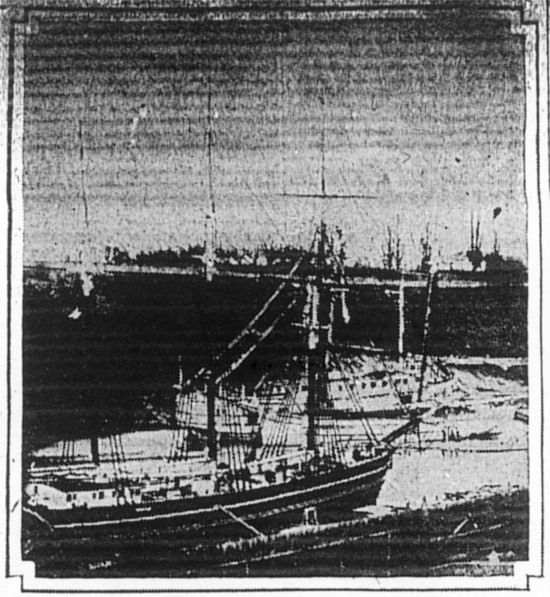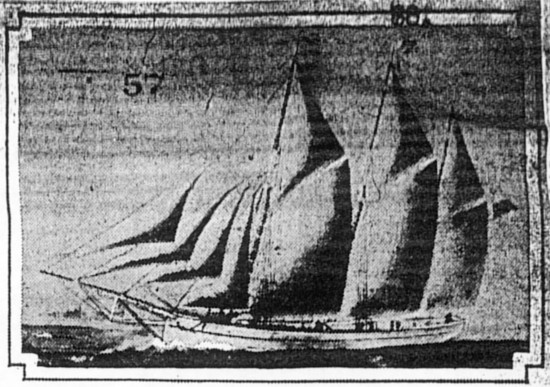An Early Oiler
Toronto Telegram, 3 September 1932
Schooner DaysLVII (57)
By C.H.J. Snider
In this issue the author looks at the beginnings of the oil trade out of Sarnia, and how the barquentine Prince of Wales, later renamed the Sligo and re-rigged as a schooner, was probably the first Canadian vessel to carry oil to London, England. The Sligo ended her career as a stone hooker. The images are from 1970s era "photocpoies" of the original Toronto Telegram article in our Gary Mauthe fonds. Note: some twelve years later, he author wrote "The pickled Prince" containing very similar images, which were in much better condition.

For to tell you what we know
Of marching with the Mulligan Guards
To Sligo port below –
And then there was the Sligo.
This was another of the old wooden walls of the lakes which braved the perils of the oceans successfully, and ended her days through the more exacting demands of freshwater navigation.
Many "old" sailors have scoffed at the idea of the Sligo ever being off fresh water, but that is because their memories did not go back far enough, although they had known her for fifty years. It is seventy-one years since she sailed from Sarnia with oil for London; just as casually as that. And besides she was then as different from her later self, which these "old" sailors only knew, as night is from day.
First time the writer saw the Sligo was in 1908, when Haney and Miller, contractors for the waterworks tunnel under Toronto Bay, had blossomed into the crushed stone trade. They brought over from St. Catharines a tow-barge which had been doing nothing for some years; a white painted, straight sided, round-nosed thing, with a weary expression in her goggle-eyed hawse-pipes.
"Old canaller" was written all over her, in her shape and the scoring of her oaken sides by forty or fifty years of grinding lock walls. Anyone could tell that she had once been "a vessel," as waterfront parlance distinguished craft built for sailing from craft built for steaming or towing.
In fact her schooner's foremast, with its heavy-timbered cross trees, like an aerial sidewalk, has been left in her, and she had either a foresail rigged on it or a cargo gaff.
This was the Sligo of St. Catharines, as her name proclaimed, and Haney and Miller used her to carry loads of crushed stone from their Point Ann quarries in the Bay of Quinte to the old Adamson elevator at the foot of West Market street. All this crushed stone was used in concrete work.

The Sligo survived the racketting of being dragged up and down Lake Ontario, light or loaded, behind a tug, until one morning two years later, when the sides of the elevator burst out and a few thousand tons of stone, timber and galvanized iron descended on her as she lay in the slip alongside. The weight was so heavy that it forced her to the bottom, but it could not break her back or her spirit. If memory serves correctly, she was enjoying a serene senility along with the Albacore and A. Muir and Antelope, all dismantled at the Point Ann quarries when the writer whirled by them in the yawl Blue Peter in 1916.
When the Sligo came into this stone trade it was asserted, and denied, that she had been over the ocean. The fact was that she had not been – as the Sligo – but she did go across thirteen years before her Sligo incarnation.
She was built at St. Catharines in 1860 by Louis Shickluna and, like more than one vessel launched in that historic year, was christened Prince of Wales. But she had better claim to the title than others, for the royal Albert Edward, who was seeing all there was to be seen in America at this time, went aboard her when she was lying in Chicago, loading grain for Collingwood, and was photographed on deck with the mayor of Chicago and her captain and owner, John C. Graham, of St. Catharines. The Graham family treasure that photograph to this day. Thomas' Register of 1864 gives Norris and Neelon as owners of the Prince of Wales, but Capt. Graham either had her built or bought her soon after her launching, and owned her for many years [In fact, Capt Graham was only registered as owner in 1869. Ed.] When launched she had an insurable value of $20,000.
The Sligo was white. The Prince of Wales was black. The Sligo was a schooner, fore-and-aft rigged on all three masts. The Prince of Wales was square-rigged forward – a barquentine. So there was some excuse for not recognizing the one in the other.
The year following the royal visit the Prince of Wales loaded a cargo of coal-oil in barrels at Sarnia, and sailed down the river and the lakes and canals and across the Atlantic to London.
This was at the beginning of the export of oil from Canada, and may have been the first cargo. A thriving trade developed, and among the lake vessels which made voyages from the Sarnia district with oil for England were the schooner Sirius, which was wrecked at Father Point on the way out, Oct. 20th, 1862, and the schooner Gotten, Capt. Geo. H. Black, of Buffalo, which made the biggest blaze ever seen in Lake Erie, when she caught fire on the way down. She was totally destroyed. The schooner Naragansett, Capt. Murphy, made a successful passage from the lakes to London with petroleum, in 1867, and the barquentines Thermutus and Wirralite went from Cleveland to Liverpool with oil and staves in 1870.
Capt. Robt. Maw, of Toronto, also carried Sarnia oil to England at this time in his schooner Gulnare, but his trade was from Montreal, the oil being brought to him by his partner in a schooner from Lake Huron.
This was, of course, before Imperial Oil made Sarnia a gasoline centre. Gasoline was at this time a waste by-product, running into the river, when the coal-oil was being refined from the crude petroleum, to replace whale oil and candles in the stately homes of England.
The Prince of Wales made a successful voyage to London, and is said to have gone thence to Cape Town, as did the lake brigantine Sea Gull in 1864. When she came back to the lakes she found the common prejudice against a "coal oil can for a bushel measure." The oil was supposed to have impregnated her ceiling or inner planking, and to taint cargoes of grain or flour. It was long before the days of the sanitary modern tanker, with her oil-proof compartments.
So Capt. Graham had her torn inside out and rebuilt and renamed the Sligo – why, who knows? Perhaps with that rollicking tune of the Mulligan Guards in his head.
The Irish were strong along the Welland Canal – the Sullivan brothers, John and Pat, were hammering hallelujah out of schooners for the Woodruffs and Battles and Conlons at this time, and Capt. Michael Kerwin, a famous sail dragger, was placed by Capt. Graham in charge of the Sligo with instructions to beat the Sullivans even if he took the whiskers out of the vessel.
It is uncertain whether Mike Kerwin or John Sullivan or Pat was the victor in the combat, which raged over years, but all three succeeded in dismasting their charges one way or another. After Michael had torn out one set of spars by the roots the Sligo was re-rigged as a three-masted schooner; and so her metamorphosis from the barquentine Prince of Wales was complete.
As rebuilt in 1874 the Sligo measured 138 feet on deck, 23 feet beam, 11 feet 8 inches depth of hold, and 335 tons register; typical dimensions for the old Welland Canal locks. She carried the first cargo of western prairie grain out of Fort William in 1883, seventeen thousand bushels of No. 1 hard wheat, loaded into her with wheelbarrows in a week of sweating work. What a contrast to the Lemoyne's pick-up of six hundred thousand bushels at the same place now in six hours!
When the Sligo loaded the first wheat cargo at Fort William Capt. Jerry Clifford, another Welland Canal Irisher, spoonfed the steam barge Erin with 10,000 bushels of wheat at the twin town across the way. The Erin was then owned by Conlon Brothers, of Thorold, and this cargo was the first out of Port Arthur.
"I remember it well going into the Erin," the late Magistrate J. J. O'Connor, Thunder Bay District, told the writer. "It was in September, 1883, and there were no grain elevators here then. The Erin lay at the old Marks wharf, and the wheat was shovelled out of box cars into pushcarts, and wheeled over the Erin's rail to her hatches. She was a singledeck steam barge at this time. She was driven ashore late that same fall on Keeweenaw Point on the south shore of Lake Superior, and lay there all winter. Floated in the spring, lengthened, and converted into a double-decker. After that Capt. Pat Sullivan commanded her for the rest of her life. He always kept her painted as green as the island that gave her her name; and the barge she towed, the F. L. Danforth, was green.
Like the Erin, the Sligo was operated in the great construction work on the north shore of Lake Superior which produced the C. P. R. in the years 1882-86, and had many adventures loading and unloading on that wilderness coast. George A. Graham, son of Captain John C. Graham, was then her managing owner, and Mike Kerwin gave her gaunt bones many a racking. No wonder she looked a little weary when Haney and Miller got her for the crushed stone trade.
